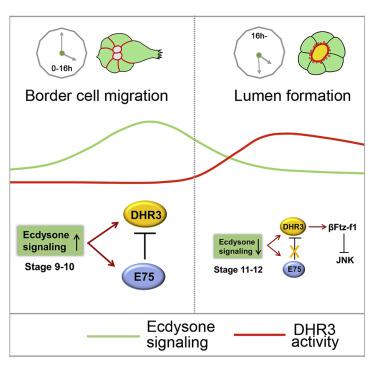iScience ( IF 4.6 ) Pub Date : 2020-07-01 , DOI: 10.1016/j.isci.2020.101335 Xianping Wang 1 , Heng Wang 1 , Lin Liu 1 , Sheng Li 2 , Gregory Emery 3 , Jiong Chen 1

|
During development, cells undergo multiple, distinct morphogenetic processes to form a tissue or organ, but how their temporal order and time interval are determined remain poorly understood. Here we show that the nuclear receptors E75 and DHR3 regulate the temporal order and time interval between the collective migration and lumen formation of a coherent group of cells named border cells during Drosophila oogenesis. We show that E75, in response to ecdysone signaling, antagonizes the activity of DHR3 during border cell migration, and DHR3 is necessary and sufficient for the subsequent lumen formation that is critical for micropyle morphogenesis. DHR3's lumen-inducing function is mainly mediated through βFtz-f1, another nuclear receptor and transcription factor. Furthermore, both DHR3 and βFtz-f1 are required for chitin secretion into the lumen, whereas DHR3 is sufficient for chitin secretion. Lastly, DHR3 and βFtz-f1 suppress JNK signaling in the border cells to downregulate cell adhesion during lumen formation.
中文翻译:

两个核受体之间的拮抗作用导致集体迁移和管腔形成的时间协调。
在发育过程中,细胞经历多个不同的形态发生过程以形成组织或器官,但如何确定其时间顺序和时间间隔仍然知之甚少。在这里,我们显示核受体E75和DHR3调节果蝇期间果胶形成的一组连贯细胞(称为边界细胞)的集体迁移和管腔形成之间的时间顺序和时间间隔卵子发生。我们表明,E75,响应蜕皮激素信号转导,在边界细胞迁移过程中拮抗DHR3的活性,而DHR3对于后续的管腔形成是必要且足够的,这对于微粒的形态发生至关重要。DHR3的管腔诱导功能主要通过另一种核受体和转录因子βFtz-f1介导。此外,DHR3和βFtz-f1都需要几丁质分泌到管腔中,而DHR3足够几丁质分泌。最后,DHR3和βFtz-f1抑制边界细胞中的JNK信号传导,从而在管腔形成过程中下调细胞粘附。











































 京公网安备 11010802027423号
京公网安备 11010802027423号